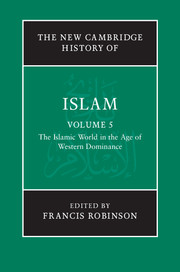Book contents
- Frontmatter
- Introduction
- PART I THE ONSET OF WESTERN DOMINATION C. 1800 TO C. 1919
- 1 The Ottoman lands to the post-First World War settlement
- 2 Egypt to c. 1919
- 3 Sudan, Somalia and the Maghreb to the end of the First World War
- 4 Arabia to the end of the First World War
- 5 Iran to 1919
- 6 Russia, Central Asia and the Caucasus to 1917
- 7 Afghanistan to 1919
- 8 South Asia to 1919
- 9 South-East Asia and China to 1910
- 10 Africa south of the Sahara to the First World War
- PART II INDEPENDENCE AND REVIVAL C. 1919 TO THE PRESENT
- Glossary
- Bibliography
- Index
- References
5 - Iran to 1919
from PART I - THE ONSET OF WESTERN DOMINATION C. 1800 TO C. 1919
Published online by Cambridge University Press: 28 March 2011
- Frontmatter
- Introduction
- PART I THE ONSET OF WESTERN DOMINATION C. 1800 TO C. 1919
- 1 The Ottoman lands to the post-First World War settlement
- 2 Egypt to c. 1919
- 3 Sudan, Somalia and the Maghreb to the end of the First World War
- 4 Arabia to the end of the First World War
- 5 Iran to 1919
- 6 Russia, Central Asia and the Caucasus to 1917
- 7 Afghanistan to 1919
- 8 South Asia to 1919
- 9 South-East Asia and China to 1910
- 10 Africa south of the Sahara to the First World War
- PART II INDEPENDENCE AND REVIVAL C. 1919 TO THE PRESENT
- Glossary
- Bibliography
- Index
- References
Summary
Iran entered the nineteenth century heaving from nearly a century of war and political turmoil. In 1722, the Safavid dynasty succumbed to an ignominious end at the hands of its Afghan vassals, inaugurating a prolonged period of political turmoil which witnessed the dramatic rise and fall of Nādir Shāh (r. 1736–47) and the comparative stability of Karīm Khān Zand (r. 1751–79), to be followed in turn by another bout of tribal and political conflict until qā Muḥammad Khān (r. 1796–7), a scion of the Qājār tribe and lead contender to succeed the throne vacated by the Safavids, finally established himself as patriarch of a new dynasty in 1796. Like his predecessors, qā Muḥammad Khān was forced to conquer the country from within and to fight to maintain the territorial integrity of the state he wished to inherit. But unlike his immediate predecessors, his hegemony proved sufficiently complete that he was able to ensure a peaceful succession, an achievement all the more remarkable given that he had no direct heirs of his own. The Qājār dynasty continued to reign (if not rule) over the ‘Guarded Domains of Iran’ until 1925, a period of comparative stability which nonetheless witnessed profound changes in the character and nature of the Iranian state, especially with respect to its international status.
- Type
- Chapter
- Information
- The New Cambridge History of Islam , pp. 154 - 179Publisher: Cambridge University PressPrint publication year: 2010

